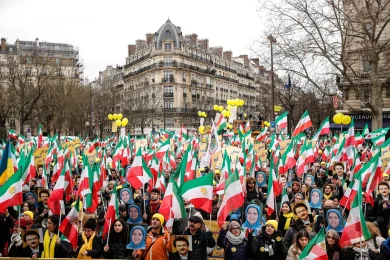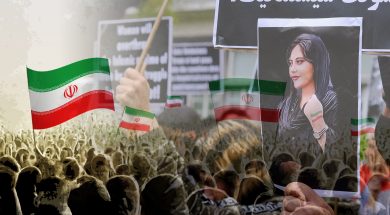Iran’s prisons have become symbols of oppression, where women activists, journalists, and dissidents endure torture, solitary confinement, and psychological abuse for defying the regime. Under the control of the Islamic Revolutionary Guard Corps (IRGC), these prisons function as centers of state repression, aiming to break the spirit of those who challenge the government’s authoritarian rule.
Yet, despite harsh conditions, many women refuse to be silenced. From Narges Mohammadi’s human rights advocacy to Sepideh Gholian’s resistance behind bars, these women have turned prison cells into battlegrounds for justice. This analysis explores the IRGC’s use of incarceration to silence dissent, the conditions inside Iran’s notorious prisons, and how women’s resilience continues to fuel the movement for freedom.
1. The IRGC’s Weaponization of Prisons Against Women
A. The IRGC’s Role in Political Repression
The IRGC plays a central role in arresting, torturing, and imprisoning women who:
• Expose human rights abuses
• Speak out against the regime’s gender oppression
• Report on protests and government corruption
• Reject the compulsory hijab laws
The IRGC’s intelligence wing monitors social media, infiltrates activist groups, and conducts midnight raids to detain women without fair trials.
B. Common Charges Against Women Activists
Women in Iran are routinely imprisoned under vague and fabricated charges such as:
• “Propaganda against the state”
• “Acting against national security”
• “Spreading corruption on Earth” (a charge that can carry the death penalty)
• “Collaboration with foreign enemies”
In reality, many of these women are arrested simply for speaking the truth or advocating for basic human rights.
2. Life Inside Iran’s Most Notorious Prisons
A. Evin Prison: Iran’s “Torture Factory”
Evin Prison, located in Tehran, is one of the most infamous detention centers controlled by the IRGC. It is notorious for:
• Torture and sexual abuse against female prisoners.
• Interrogation techniques designed to force false confessions.
• Solitary confinement, sometimes lasting months.
• Denial of medical treatment, leaving sick prisoners to suffer.
Prominent activists like Narges Mohammadi and Nasrin Sotoudeh have endured years of imprisonment in Evin, yet continue to resist.
B. Qarchak Prison: Hell for Women
Qarchak Prison, located in Varamin, is often referred to as the worst prison for women in Iran. Unlike Evin, which houses political prisoners separately, Qarchak places political detainees alongside violent criminals, increasing their risk of assault and mistreatment.
Conditions include:
• Overcrowded, unsanitary cells with no proper ventilation.
• Limited access to food, clean water, and hygiene products.
• Frequent physical and sexual abuse by prison guards.
• Psychological torture, including threats against family members.
Despite these inhumane conditions, women detainees in Qarchak continue their fight for justice, refusing to be broken.
3. Women Who Resist from Behind Bars
A. Narges Mohammadi: A Voice of Defiance
Narges Mohammadi, a prominent human rights activist, has spent years in and out of prison for:
• Campaigning against the death penalty.
• Exposing the IRGC’s human rights violations.
• Defending women’s rights against forced hijab laws.
Despite torture, solitary confinement, and denial of medical care, she continues to write letters and reports from prison, ensuring that the world does not forget the suffering of Iran’s women.
B. Sepideh Gholian: A Journalist Who Won’t Be Silenced
Sepideh Gholian, a labor rights activist and journalist, has been repeatedly arrested for covering workers’ strikes and human rights violations.
She has:
• Endured brutal interrogations aimed at forcing a false confession.
• Been subjected to repeated arrests for speaking out after her release.
• Chanted anti-regime slogans upon release, only to be re-arrested within hours.
Her resilience shows that fear tactics will not silence Iran’s women.
C. Atena Daemi: The Unbreakable Activist
Atena Daemi, an activist against child executions and political repression, has faced:
• Physical and psychological torture in Evin Prison.
• Multiple hunger strikes to protest human rights violations.
• Years of imprisonment for simply advocating justice.
Despite her suffering, she remains a symbol of resistance.
4. Why the IRGC Fears Women’s Resistance
The Iranian regime relies on fear and repression to maintain control. But women prisoners, rather than being silenced, have become symbols of defiance.
The IRGC fears these women because:
1. Their voices expose the regime’s brutality.
2. They inspire national and global resistance.
3. Their imprisonment fuels more protests instead of stopping them.
Instead of breaking the spirit of these women, the regime has unintentionally created heroes whose stories continue to mobilize people inside and outside Iran.
5. Global Responsibility: How the World Can Help
A. Demand the Release of Political Prisoners
• Governments and international organizations must pressure Iran to release all women imprisoned for political activism.
• United Nations human rights bodies should investigate abuses in Iran’s prisons.
B. Sanctions on IRGC Officials
• Targeted sanctions should be imposed on IRGC officials responsible for:
✔ Torture and abuse of prisoners.
✔ Enforcing gender-based oppression.
✔ Running Iran’s most notorious prisons.
C. Digital and Humanitarian Support
• Secure communication tools should be provided to activists to help them expose human rights violations.
• International groups should support the families of political prisoners with legal aid and financial assistance.
D. Amplify the Voices of Women Prisoners
• Journalists and human rights organizations must continue covering the stories of imprisoned women, ensuring they are not forgotten.
• Social media activism through #FreeIranianWomen and #WomenLifeFreedom can keep global attention on their cases.
Conclusion: Resistance Behind Bars Will Free Iran
Iran’s women prisoners are not just victims—they are leaders of resistance. Their courage behind bars fuels the fight for a free Iran. Despite torture, isolation, and fear tactics, they continue to speak out, proving that imprisonment cannot silence the truth.
The world must stand with them. Governments, activists, and ordinary citizens have a moral responsibility to support Iranian women in prisons, demand their freedom, and hold the IRGC accountable.
Join Our Newsletter!
Stay informed with the latest updates, news, and ways to take action in the fight for justice and global security. Sign up now to get updates delivered straight to your inbox!





